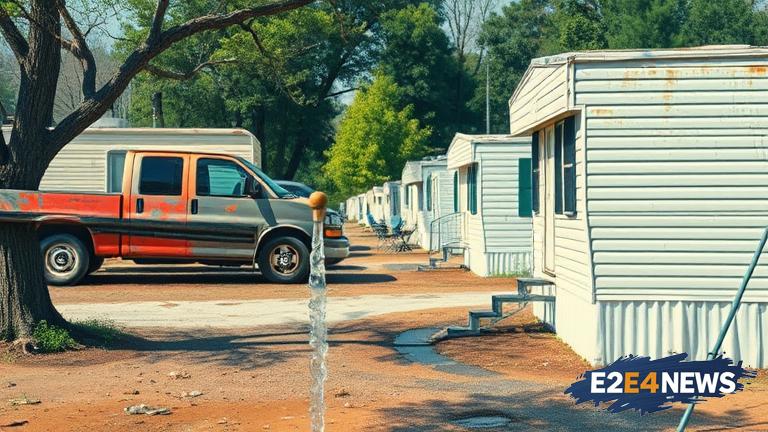A disturbing trend has been uncovered in the United States, where mobile home parks are routinely violating clean water standards, putting the health and well-being of thousands of residents at risk. According to a recent analysis, many of these parks are failing to provide safe and clean drinking water, with some even exceeding acceptable limits for contaminants such as lead, arsenic, and bacteria. The study found that mobile home parks in nearly every state are struggling to meet the minimum requirements for clean water, with some parks showing shocking levels of contamination. The issue is particularly pronounced in low-income communities, where residents may not have the resources or knowledge to advocate for themselves. The analysis revealed that many mobile home parks are not properly maintaining their water treatment systems, leading to a buildup of harmful contaminants. In some cases, parks are not even testing their water regularly, making it difficult to identify and address problems. The consequences of this neglect can be severe, with residents facing increased risks of waterborne illnesses, cancer, and other health problems. The situation is particularly dire for vulnerable populations such as children, the elderly, and those with pre-existing medical conditions. Despite the gravity of the situation, many mobile home parks are not taking adequate steps to address the issue, with some even attempting to cover up the problem. The analysis highlights the need for greater oversight and regulation of mobile home parks, as well as increased funding for water infrastructure and testing. It also underscores the importance of community engagement and education, as residents must be empowered to demand clean and safe drinking water. The US Environmental Protection Agency (EPA) has set strict standards for clean water, but the agency often lacks the resources and authority to enforce these standards effectively. As a result, it is up to individual states and local governments to take action, which can be a slow and difficult process. In recent years, there have been efforts to increase funding for water infrastructure and to strengthen regulations, but much work remains to be done. The issue of clean water in mobile home parks is complex and multifaceted, involving not only technical and infrastructure challenges but also social and economic factors. Mobile home parks are often located in rural or low-income areas, where access to resources and services may be limited. Additionally, the transient nature of mobile home park residents can make it difficult to build a sense of community and to mobilize advocacy efforts. However, there are also many examples of successful initiatives and collaborations that have improved access to clean water in mobile home parks. These efforts often involve partnerships between local governments, community organizations, and private companies, and may include measures such as water testing and treatment, infrastructure upgrades, and education and outreach programs. By working together and sharing knowledge and resources, it is possible to address the issue of clean water in mobile home parks and to ensure that all residents have access to safe and healthy drinking water. The analysis serves as a wake-up call for policymakers, regulators, and community leaders, highlighting the need for urgent action to address this critical issue. It also emphasizes the importance of ongoing monitoring and evaluation, as well as continuous community engagement and education. Ultimately, the goal must be to ensure that all mobile home parks in the US are providing clean and safe drinking water, and that residents are empowered to demand and expect nothing less. The situation is a stark reminder of the ongoing struggles faced by many communities in the US, where access to basic necessities like clean water and sanitation is often a daily challenge. As the US continues to grapple with issues of inequality and social justice, the issue of clean water in mobile home parks must be a priority. By working together to address this issue, we can help to build healthier, more sustainable communities, and to ensure that all residents have access to the resources and opportunities they need to thrive.





